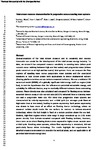Tidal stream resource characterisation in progressive versus standing wave systems
| dc.contributor.author | Ward, SL | en |
| dc.contributor.author | Robins, PE | en |
| dc.contributor.author | Lewis, MJ | en |
| dc.contributor.author | Iglesias, G | en |
| dc.contributor.author | Hashemi, MR | en |
| dc.contributor.author | Neill, SP | en |
| dc.date.accessioned | 2018-04-30T15:07:23Z | |
| dc.date.available | 2018-04-30T15:07:23Z | |
| dc.date.issued | 2018-06-15 | en |
| dc.identifier.issn | 0306-2619 | en |
| dc.identifier.uri | http://hdl.handle.net/10026.1/11378 | |
| dc.description.abstract |
© 2018 The Author(s) Characterisations of the tidal stream resource and its variability over various timescales are crucial for the development of the tidal stream energy industry. To date, no research has compared resource sensitivity in standing wave (when peak currents occur midway between high and low water) and progressive wave (where peak currents occur at high and low water) tidal systems. Here, we compare the flow regimes of standing wave versus progressive wave systems and the associated variations in tidal stream power with applications to device deployment options (floating-platform turbines versus bottom-mounted turbines). We use a validated 3D numerical model (ROMS) of a globally-significant tidal energy shelf sea region (Irish Sea), to test the hypotheses that the influence on potential extractable energy, and suitability for different devices, may be markedly different between these contrasting systems. Power density was also calculated and compared for floating versus bottom-mounted devices using in-situ current data (ADCPs) obtained from a standing wave site and a progressive wave site. We show that progressive wave systems are characterised by velocity-asymmetry over a tidal cycle (i.e. stronger peak flows at high water than at low water), leading to power-asymmetry. Such power asymmetry was shown to have more of an effect on floating device technology, where an assumed turbine depth tracks the sea surface, in contrast to bottom-mounted technology, where the hub height is fixed at a certain position above the sea bed. Shallow, high-flow regions where tidal range is large contained up to 2.5% more power density from bottom-mounted compared with floating turbines; however, there were areas where floating devices were exposed to higher mean currents over a tidal cycle. Standing wave systems, where flow asymmetry is minimised, did not particularly favour either technology. The results highlight the requirement for detailed resource assessments to consider the vertical plane, and are applicable to all potential tidal stream energy sites. | en |
| dc.format.extent | 274 - 285 | en |
| dc.language.iso | en | en |
| dc.title | Tidal stream resource characterisation in progressive versus standing wave systems | en |
| dc.type | Journal Article | |
| plymouth.volume | 220 | en |
| plymouth.journal | Applied Energy | en |
| dc.identifier.doi | 10.1016/j.apenergy.2018.03.059 | en |
| plymouth.organisational-group | /Plymouth | |
| plymouth.organisational-group | /Plymouth/Faculty of Science and Engineering | |
| plymouth.organisational-group | /Plymouth/Research Groups | |
| plymouth.organisational-group | /Plymouth/Research Groups/Marine Institute | |
| plymouth.organisational-group | /Plymouth/Users by role | |
| dcterms.dateAccepted | 2018-03-22 | en |
| dc.rights.embargoperiod | Not known | en |
| rioxxterms.versionofrecord | 10.1016/j.apenergy.2018.03.059 | en |
| rioxxterms.licenseref.uri | http://www.rioxx.net/licenses/all-rights-reserved | en |
| rioxxterms.licenseref.startdate | 2018-06-15 | en |
| rioxxterms.type | Journal Article/Review | en |


